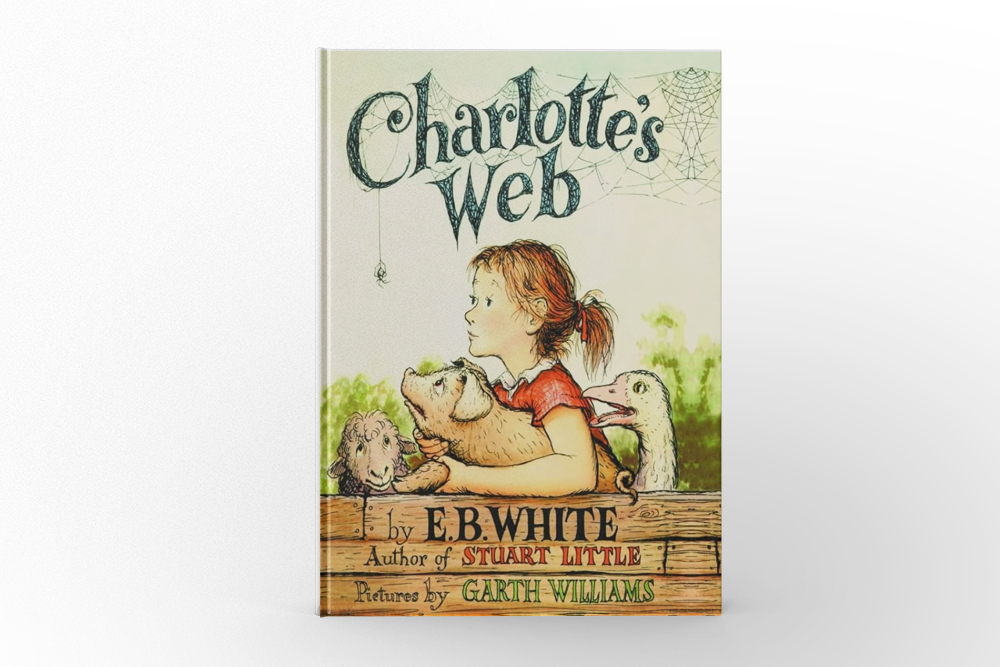“Charlotte’s Web by E.B. White” is a beloved classic that has touched the hearts of readers for generations. This enchanting tale of friendship, loyalty, and the cycle of life is a staple in children’s literature, offering profound lessons wrapped in a simple yet captivating story.
Author’s Background
E.B. White, born Elwyn Brooks White in 1899, was an American writer known for his contributions to literature and journalism. White’s career spanned several decades, during which he wrote for The New Yorker and authored numerous books, including “Stuart Little” and “The Trumpet of the Swan.” His ability to craft stories that resonate with both children and adults has cemented his place as one of the most influential writers of the 20th century. “Charlotte’s Web,” published in 1952, remains one of his most celebrated works.
In Depth Summary
“Charlotte’s Web by E.B. White” begins with a young girl named Fern Arable saving a runt piglet from being slaughtered by her father. She names the pig Wilbur and raises him with love and care. However, as Wilbur grows, he is moved to her uncle’s farm, where he befriends a wise and kind spider named Charlotte.
Wilbur soon learns that he is destined for the slaughterhouse, and in a bid to save him, Charlotte devises a plan. She begins to weave words into her web, such as “Some Pig,” “Terrific,” “Radiant,” and “Humble,” to highlight Wilbur’s uniqueness and worth. These miraculous webs attract the attention of the farmers and the wider community, turning Wilbur into a local celebrity.
As the story progresses, Wilbur is entered into the county fair, where he wins a special prize, ensuring his safety. However, the joy of Wilbur’s victory is tempered by the realization that Charlotte’s life is coming to an end. She has expended all her energy to save Wilbur and is now too weak to return to the farm. In a poignant and emotional farewell, Charlotte passes away, leaving behind her egg sac, which Wilbur takes back to the farm.
Wilbur cares for Charlotte’s eggs, and when they hatch, most of the baby spiders leave, but three stay behind, continuing Charlotte’s legacy. The story concludes with Wilbur living a happy life, always remembering the sacrifice and friendship of Charlotte.
Themes and Insights
“Charlotte’s Web by E.B. White” is rich with themes that resonate deeply with readers. One of the central themes is the power of friendship. The bond between Wilbur and Charlotte is a testament to the strength and importance of true friendship. Charlotte’s selfless acts to save Wilbur highlight the lengths to which friends will go to protect and support each other.
Another significant theme is the cycle of life. The story does not shy away from the realities of life and death, presenting them in a way that is accessible and understandable for children. Charlotte’s death, while sad, is portrayed as a natural part of life, teaching readers about the inevitability of change and the importance of cherishing the moments we have.
The theme of identity and self-worth is also prominent. Through Charlotte’s webs, Wilbur learns to see himself as special and valuable. This theme underscores the idea that everyone has inherent worth and that sometimes, it takes the perspective of a friend to help us see it.
Personal Reflections
Reading “Charlotte’s Web by E.B. White” as an adult offers a different perspective compared to reading it as a child. The story’s emotional depth and the complexity of the characters’ relationships become more apparent. As a child, the adventure and the talking animals are the focal points, but as an adult, the underlying themes of friendship, sacrifice, and the cycle of life take center stage.
The book’s illustrations, originally by Garth Williams, add to its charm. The detailed and expressive drawings bring the story to life, making the characters and their world feel real and relatable. The interplay between the text and the illustrations creates a rich, immersive experience that leaves a lasting impression.
Recommendation
“Charlotte’s Web by E.B. White” is a must-read for both children and adults. Its timeless appeal lies in its ability to speak to readers on multiple levels. For children, it is an exciting adventure story filled with talking animals and miraculous events. For adults, it is a poignant exploration of friendship, sacrifice, and the cycle of life. This book is a valuable addition to any library and a wonderful gift for readers of all ages.
Impact and Legacy
Since its publication in 1952, “Charlotte’s Web by E.B. White” has had a profound impact on children’s literature. It has been translated into numerous languages and has sold millions of copies worldwide. The book’s success led to various adaptations, including animated films, a live-action movie, and even a stage play.
White’s work has influenced countless authors and illustrators, inspiring them to explore deeper themes in children’s literature. The book’s legacy is evident in its continued popularity and its presence in educational curricula around the world. It has become a cultural touchstone, referenced in various forms of media and celebrated for its artistic and literary merit.
Conclusion
“Charlotte’s Web by E.B. White” is more than just a children’s book; it is a timeless masterpiece that continues to captivate and inspire readers of all ages. Its exploration of friendship, the cycle of life, and the importance of self-worth make it a deeply resonant and meaningful story. E.B. White’s legacy as a pioneering author is firmly cemented through this beloved work, which will undoubtedly continue to enchant and influence future generations.
